Development and Validation of 96-Microwell-Based Spectrophotometric and High-Performance Liquid Chromatography with Fluorescence Detection Methods with High Throughput for Quantitation of Duvelisib and Seliciclib in Their Bulk Forms and Capsules
Abstract
:1. Introduction
2. Experimental
2.1. Apparatus
2.2. Chemicals and Materials
2.3. Preparation of Standard and Sample Solutions
2.3.1. Standard Solutions
2.3.2. Capsules Sample Solutions
2.4. Recommended Procedures
2.4.1. MW-SPM
2.4.2. HPLC-FD
3. Results and Discussion
3.1. Development of MW-SPM
3.1.1. Strategy for Method Development and Its Design
3.1.2. UV-Visible Absorption Spectra and Gap Band Energy
3.1.3. Optimization of Reaction Conditions
3.1.4. Molar Ratios and Mechanisms of the Reactions
3.2. Development of HPLC-FD
3.2.1. Background and Strategy for Method Development
3.2.2. Optimization of Chromatographic Analysis Conditions
3.2.3. Selectivity and Chromatographic Parameters
3.3. Validation of MW-SPM and HPLC-FD Methods
3.3.1. Linear Range and Sensitivity
3.3.2. Precision and Accuracy
3.3.3. Robustness and Ruggedness
3.4. Application of MW-SPM and HPLC-FD to the Analysis of Capsules
4. Conclusions
Author Contributions
Funding
Data Availability Statement
Acknowledgments
Conflicts of Interest
References
- World Health Organization. Report—12 September 2018. Available online: https://www.who.int/news-room/fact-sheets/detail/cancer (accessed on 26 June 2022).
- Bertino, J.R.; Hait, W. Principles of Cancer Therapy. In Textbook of Medicine, 22nd ed.; Golden, L., Ausiello, D., Eds.; WB Saunders: Saunders, PA, USA, 2004; pp. 1137–1150. [Google Scholar]
- Whittaker, S.; Marais, R.; Zhu, A. The role of signaling pathways in the development and treatment of hepatocellular carcinoma. Oncogene 2010, 29, 4989–5005. [Google Scholar] [CrossRef] [PubMed]
- Agarwal, E.; Brattain, M.G.; Chowdhury, S. Cell survival and metastasis regulation by Akt signaling in colorectal cancer. Cell. Signal. 2013, 25, 1711–1719. [Google Scholar] [CrossRef] [PubMed] [Green Version]
- Fruman, D.A.; Bradshaw, I.R.A.; Dennis, E.A. (Eds.) Phosphoinositide 3-Kinases. In Handbook of Cell Signaling; Academic Press: Cambridge, MA, USA, 2003; pp. 135–141. [Google Scholar]
- Malumbres, M. Cyclin-dependent kinases. Genome Biol. 2014, 15, 122. [Google Scholar] [CrossRef] [PubMed] [Green Version]
- Wang, Z.; Cole, P.A. Catalytic mechanisms and regulation of protein kinases. Methods Enzymol. 2014, 548, 1–21. [Google Scholar]
- Drake, J.M.; Lee, J.K.; Witte, O.N. Clinical targeting of mutated and wild-type protein tyrosine kinases in cancer. Mol. Cell Biol. 2014, 34, 1722–1732. [Google Scholar] [CrossRef] [Green Version]
- Knösel, T.; Kampmann, E.; Kirchner, T.; Altendorf-Hofmann, A. Tyrosine kinases in soft tissue tumors. Pathologe 2014, 35, 198–201. [Google Scholar] [CrossRef] [PubMed]
- Winkler, G.C.; Barle, E.L.; Galati, G.; Kluwe, W.M. Functional differentiation of cytotoxic cancer drugs and targeted cancer therapeutics. Regul. Toxicol. Pharmacol. 2014, 70, 46–53. [Google Scholar] [CrossRef]
- Jiao, Q.; Bi, L.; Ren, Y.; Song, S.; Wang, Q.; Wang, Y.-S. Advances in studies of tyrosine kinase inhibitors and their acquired resistance. Mol. Cancer 2018, 17, 36. [Google Scholar] [CrossRef]
- Drugbank. Duvelisib. Available online: https://go.drugbank.com/drugs/DB11952 (accessed on 26 June 2022).
- Roskoski, R., Jr. Properties of FDA-approved small molecule phosphatidylinositol 3-kinase inhibitors prescribed for the treatment of malignancies. Pharmacol. Res. 2021, 168, 105579. [Google Scholar] [CrossRef]
- Blair, H.A. Duvelisib: First global approval. Drugs 2018, 78, 1847–1853. [Google Scholar] [CrossRef]
- Flinn, I.W.; O’Brien, S.; Kahl, B.; Patel, M.; Oki, Y.; Foss, F.F.; Porcu, P.; Jones, J.; Burger, J.A.; Jain, N.; et al. Duvelisib, a novel oral dual inhibitor of PI3K-δ,γ, is clinically active in advanced hematologic malignancies. Blood 2018, 131, 877–887. [Google Scholar] [CrossRef] [PubMed]
- Drugs.com. Duvelisib. Available online: https://www.drugs.com/monograph/duvelisib.html (accessed on 26 June 2022).
- Cicenas, J.; Kalyan, K.; Sorokinas, A.; Stankunas, E.; Levy, J.; Meskinyte, I.; Stankevicius, V.; Kaupinis, A.; Valius, M. Roscovitine in cancer and other diseases. Ann. Transl. Med. 2015, 3, 135. [Google Scholar] [PubMed]
- Raje, N.; Kumar, S.; Hideshima, T.; Roccaro, A.; Ishitsuka, K.; Yasui, H.; Shiraishi, N.; Chauhan, D.; Munshi, N.C.; Green, S.R.; et al. Seliciclib (CYC202 or R-roscovitine), a small-molecule cyclin-dependent kinase inhibitor, mediates activity via down-regulation of Mcl-1 in multiple myeloma. Blood 2005, 106, 1042–1047. [Google Scholar] [CrossRef] [PubMed] [Green Version]
- Srujani, C.H.; Annapurna, P.; Nataraj, K.S.; Pawar, K.M.A. Analytlcal quality by design approach in RP-HPLC method development and validation for the estimation of duvelisib. Asian J. Pharm. Clin. Res. 2021, 14, 99–108. [Google Scholar]
- Siddesh, A.; Sriram, D.; Zakkula, A.; Kumar, R.; Dittakavi, S.; Zainuddin, M.; Trivedi, R.K.; Mullangi, R. Validated HPLC-UV method for simultaneous quantification of phosphatidylinositol 3-kinase inhibitors, copanlisib, duvelisib and idelalisib, in rat plasma: Application to a pharmacokinetic study in rats. Biomed. Chromatogr. 2021, 35, e5015. [Google Scholar] [CrossRef]
- Nigade, P.B.; Gundu, J.; Pai, K.S.; Nemmani, K.V.S. Prediction of tissue-to-plasma ratios of basic compounds in mice. Eur. J. Drug Metab. Pharmacokinet. 2017, 42, 835–847. [Google Scholar] [CrossRef]
- Shao, Y.; Xie, S.; Zhu, H.; Du, X.; Xu, R.A. Development of a novel and quick UPLC-MS/MS method for the pharmacokinetic analysis of duvelisib in beagle dogs. J. Pharm. Biomed. Anal. 2020, 187, 113355. [Google Scholar] [CrossRef]
- Sayed, A.Y.; Khalil, N.Y.; Almomen, A.; Alzoman, N.Z.; Almehizia, A.A.; Darwish, I.A. A highly sensitive nonextraction-assisted HPLC method with fluorescence detection for quantification of duvelisib in plasma samples and its application to pharmacokinetic study in rats. Drug Des. Dev. Ther. 2021, 15, 2667–2677. [Google Scholar] [CrossRef]
- Vita, M.; Meurling, L.; Pettersson, T.; Cruz-Sidén, M.; Sidén, A.; Hassan, M. Analysis of roscovitine using novel high performance liquid chromatography and UV-detection method: Pharmacokinetics of roscovitine in rat. J. Pharm. Biomed. Anal. 2004, 34, 425–431. [Google Scholar] [CrossRef]
- Vitaa, M.; Skansenb, P.; Hassana, M.; Abdel-Rehim, M. Development and validation of a liquid chromatography and tandem mass spectrometry method for determination of roscovitine in plasma and urine samples utilizing on-line sample preparation. J. Chromatogr. B 2005, 817, 303–307. [Google Scholar] [CrossRef]
- Darwish, I.A.; Almehizia, A.A.; Sayed, A.Y.; Khalil, N.Y.; Alzoman, N.Z.; Darwish, H.W. Synthesis, spectroscopic and computational studies on hydrogen bonded charge transfer complex of duvelisib with chloranilic acid: Application to development of novel 96-microwell spectrophotometric assay. Spectrochim. Acta A 2021, 264, 120287. [Google Scholar] [CrossRef] [PubMed]
- Xie, G.; Liao, M.; Wang, B.; Zhang, C. Determination of roscovitine enantiomeric purity by HPLC on chiral stationary phase. Chromatographia 2016, 79, 641–646. [Google Scholar] [CrossRef]
- Orság, P.; Fojt, L.H.L.; Coufal, J.; Brázda, V.; Fojta, M. Voltammetric behavior of a candidate anticancer drug roscovitine at carbon electrodes in aqueous buffers and a cell culture medium. Mon. Chem.—Chem. Mon. 2019, 150, 461–467. [Google Scholar] [CrossRef]
- Darwish, I.A.; Darwish, H.W.; Khalil, N.Y.; Sayed, A.Y. Experimental and computational evaluation of chloranilic acid as a universal chromogenic reagent for the development of a novel 96-microwell spectrophotometric assay for tyrosine kinase inhibitors. Molecules 2021, 26, 744. [Google Scholar] [CrossRef] [PubMed]
- Perry, G.W. High Throughput Analysis in the Pharmaceutical Industry; CRC/Taylor & Francis: Portland, OR, USA, 2009; pp. 1–72. [Google Scholar]
- Görög, S. Ultraviolet-Visible Spectrophotometry in Pharmaceutical Analysis; CRC Press: New York, NY, USA, 2018; pp. 1–504. [Google Scholar]
- Darwish, I.A. Analytical study for the charge transfer complexes of losartan potassium. Anal. Chim. Acta 2005, 549, 212–220. [Google Scholar] [CrossRef]
- Darwish, I.A.; Refaat, I.H. Spectrophotometric analysis of selective serotonin reuptake inhibitors based on formation of charge-transfer complexes with tetracyanoquinondimethane and chloranilic acid. J. AOAC Int. 2006, 89, 326–333. [Google Scholar] [CrossRef] [PubMed] [Green Version]
- El-Bagary, R.I.; Elkady, E.F.; Ayoub, B.M. Spectrophotometric methods based on charge transfer complexation reactions for the determination of saxagliptin in bulk and pharmaceutical preparation. Int. J. Biomed. Sci. 2012, 8, 204–208. [Google Scholar] [PubMed]
- Kalyanaramu, B.; Rupakumari, G.; Ramarao, K.; Raghubabu, K. Development of new visible spectrophotometric methods for quantitative determination of sumatriptan succinate based on charge-transfer complex formation. Int. J. Pharm. Pharm. Sci. Res. 2011, 1, 47–51. [Google Scholar]
- Fidler, A.T.; Baker, E.L.; Letz, R.E. Neurobehavioural effects of occupational exposure to organic solvents among construction painters. Br. J. Ind. Med. 1987, 44, 292–308. [Google Scholar] [CrossRef] [Green Version]
- Wennborg, H.; Bonde, J.P.; Stenbeck, M.; Olsen, J. Adverse reproduction outcomes among employee in biomedical research laboratories. Scand. J. Work Environ. Health 2002, 28, 5–11. [Google Scholar] [CrossRef] [Green Version]
- Lindbohm, M.L.; Taskinen, H.T.; Sallman, M.; Hemminki, K. Spontaneous abortions among women exposed to organic solvents. Am. J. Ind. Med. 2007, 17, 449–463. [Google Scholar] [CrossRef] [PubMed]
- Kristensen, P.; Hilt, B.; Svendsen, K.; Grimsrud, T.K. Incidence of lymphohaematopoietic cancer at university laboratory: A cluster investigation. Eur. J. Epidemiol. 2008, 23, 11–15. [Google Scholar] [CrossRef] [PubMed]
- Darwish, I.A.; Mahmoud, A.M.; Al-Majed, A.A. A novel analytical approach for reducing the consumption of organic solvents in the charge transfer-based spectrophotometric analysis: Application in the analysis of certain antihypertensive drugs. Acta Pharm. 2010, 60, 493–501. [Google Scholar] [CrossRef] [PubMed]
- Alzoman, N.Z.; Sultan, M.A.; Maher, H.M.; Alshehri, M.M.; Wani, T.A.; Darwish, I.A. Analytical study for the charge-transfer complexes of rosuvastatin calcium with π-acceptors. Molecules 2013, 18, 7711–7725. [Google Scholar] [CrossRef] [Green Version]
- Darwish, I.A.; Wani, T.A.; Alqarni, M.A.; Ahamad, S.R. Microwell-based spectrophotometric method for determination of azithromycin in its pharmaceutical formulations via charge transfer reaction with 2,3-dichloro-5,6-dicyano-1,4-benzoquinone. Lat. Am. J. Pharm. 2014, 33, 587–594. [Google Scholar]
- Khalil, N.Y.; Wani, T.A.; Darwish, I.A.; Assiri, I.S. Charge-transfer reaction of cediranib with 2,3-dichloro-3,5-dicyano-1,4-benzoquinone: Spectrophotometric investigation and use in development of microwell assay for cediranib. Trop. J. Pharm. Res. 2015, 14, 1667–1672. [Google Scholar] [CrossRef]
- Darwish, I.A.; Khalil, N.Y.; Alsaif, N.A.; Herqash, R.N.; Sayed, A.Y.A.; Abdel-Rahman, H.M. Charge-transfer complex of linifanib with 2,3-dichloro-3,5-dicyano-1,4-benzoquinone: Synthesis, spectroscopic characterization, computational molecular modelling and application in the development of novel 96-microwell spectrophotometric assay. Drug Des. Dev. Ther. 2021, 15, 1167–1180. [Google Scholar] [CrossRef]
- Karipcin, F.; Dede, B.; Caglar, Y.; Hür, D.; Ilican, S.; Caglar, M.; Şahin, Y. A new dioxime ligand and its trinuclear copper (II) complex: Synthesis, characterization and optical properties. Opt. Commun. 2007, 272, 131–137. [Google Scholar] [CrossRef]
- Makuła, P.; Pacia, M.; Macyk, W. How to correctly determine the band gap energy of modified semiconductor photocatalysts based on UV–Vis spectra. J. Phys. Chem. Lett. 2018, 9, 6814–6817. [Google Scholar] [CrossRef]
- Skoog, D.A.; Holler, F.J.; Crouch, S.R. Principle of Instrumental Analysis, 7th ed.; WB Saunders: Saunders, PA, USA, 2014; pp. 362–378. [Google Scholar]
- The International Council for Harmonization (ICH). Q2(R1) on Validation of Analytical Procedure; ICH: Geneva, Switzerland, 2022. [Google Scholar]
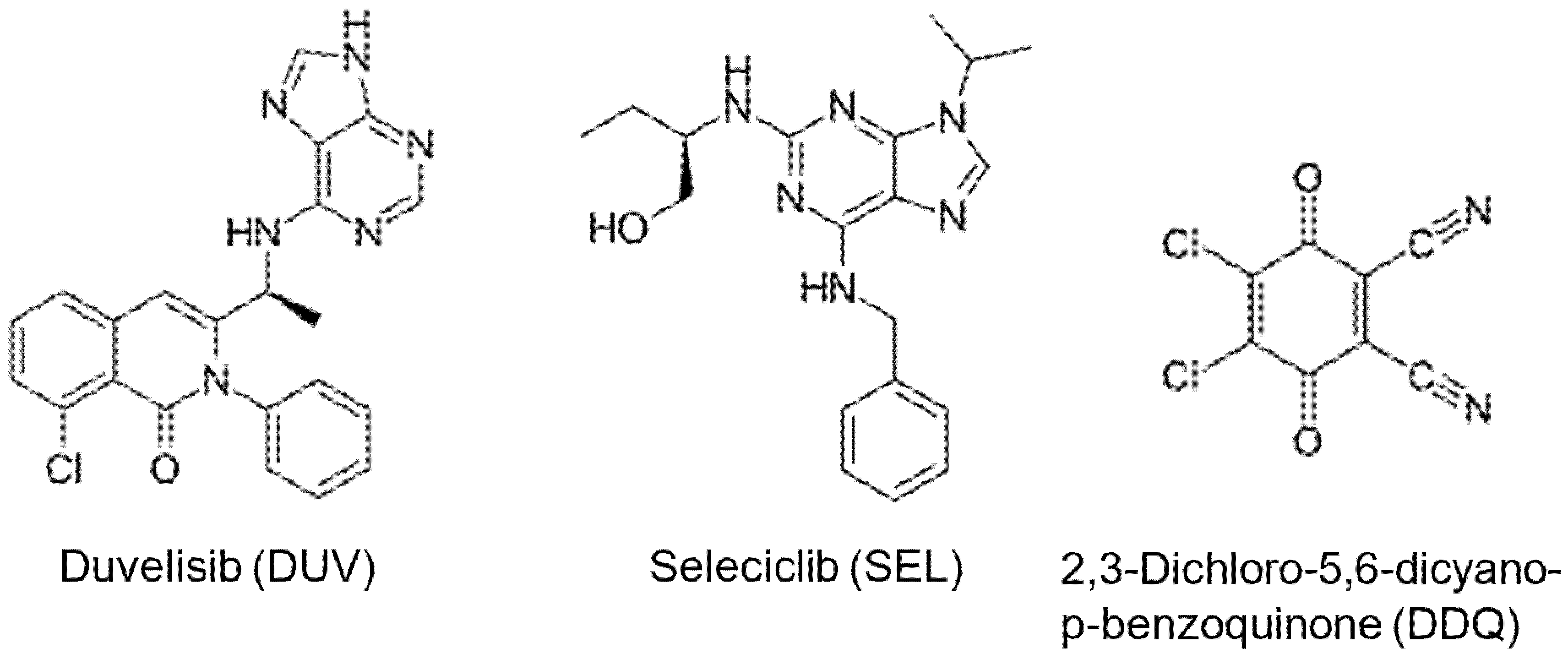
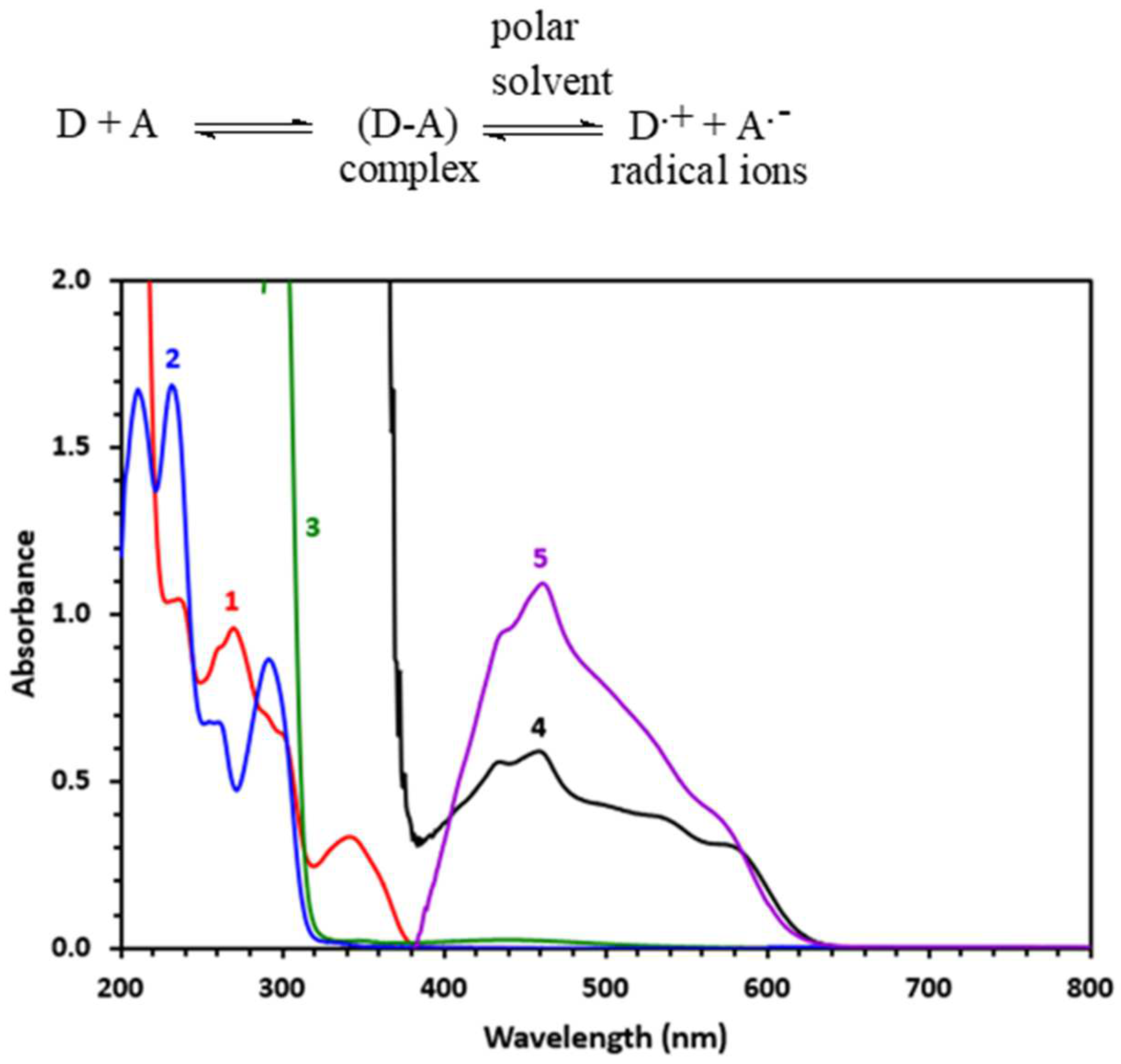
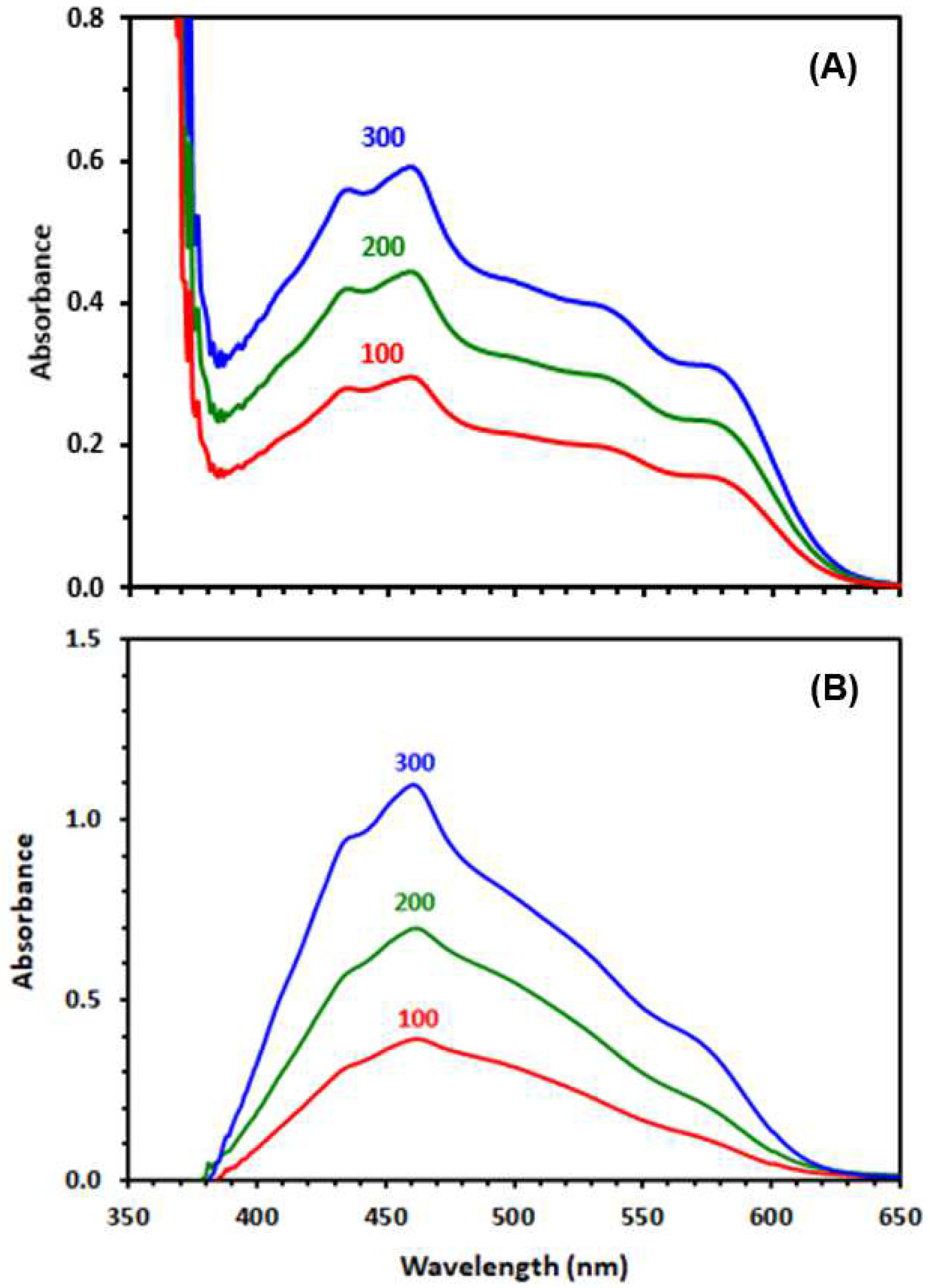

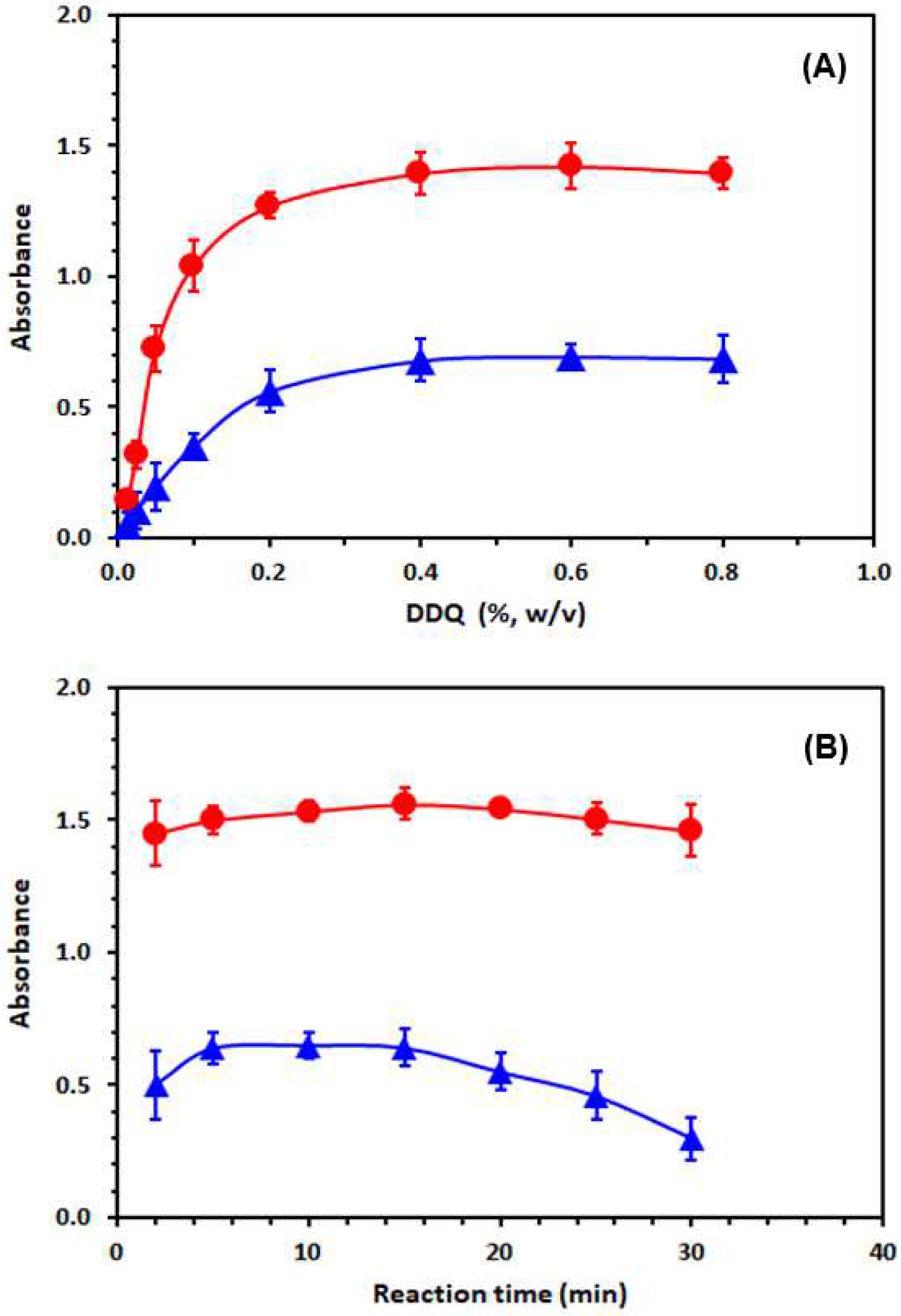
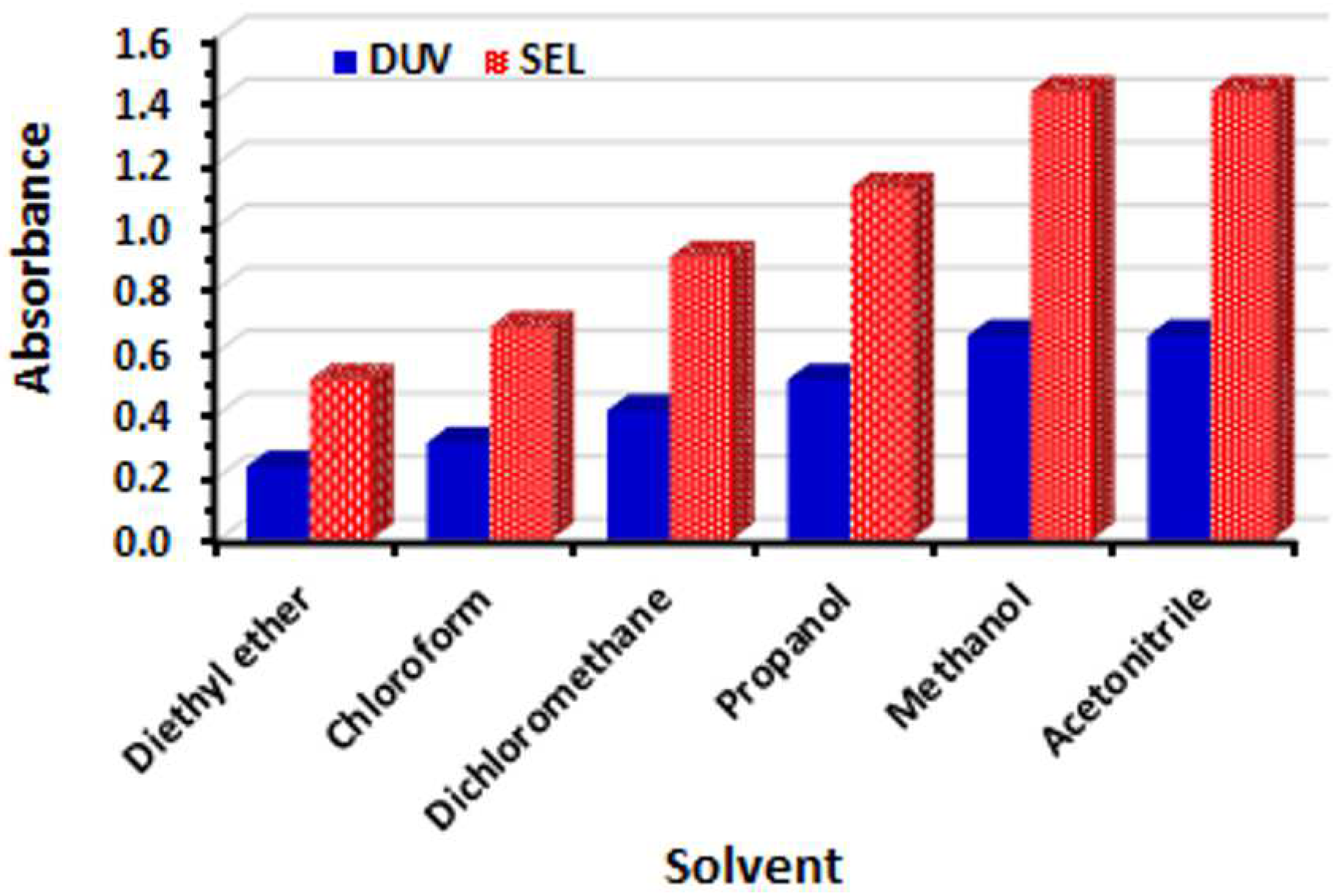
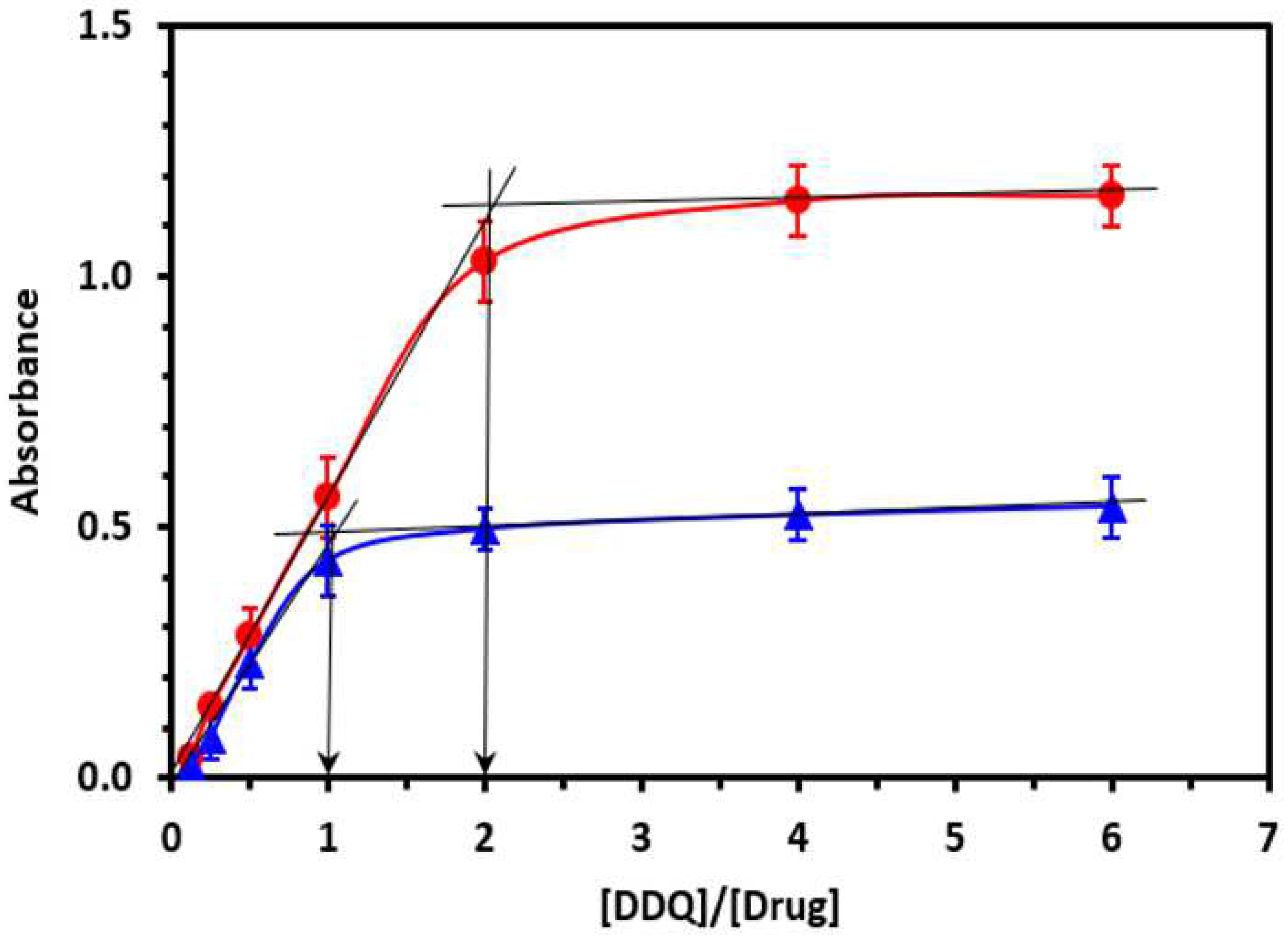


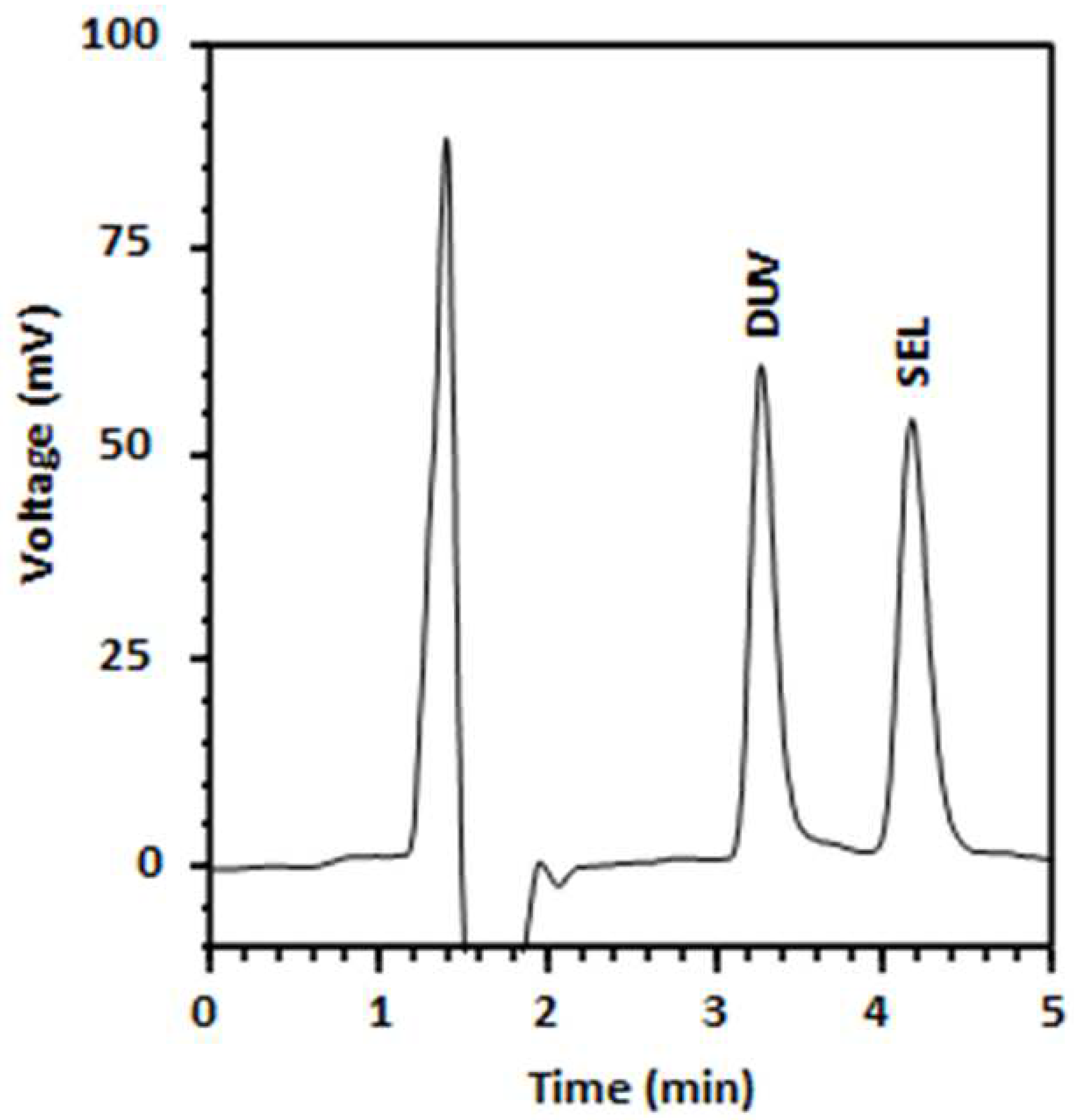
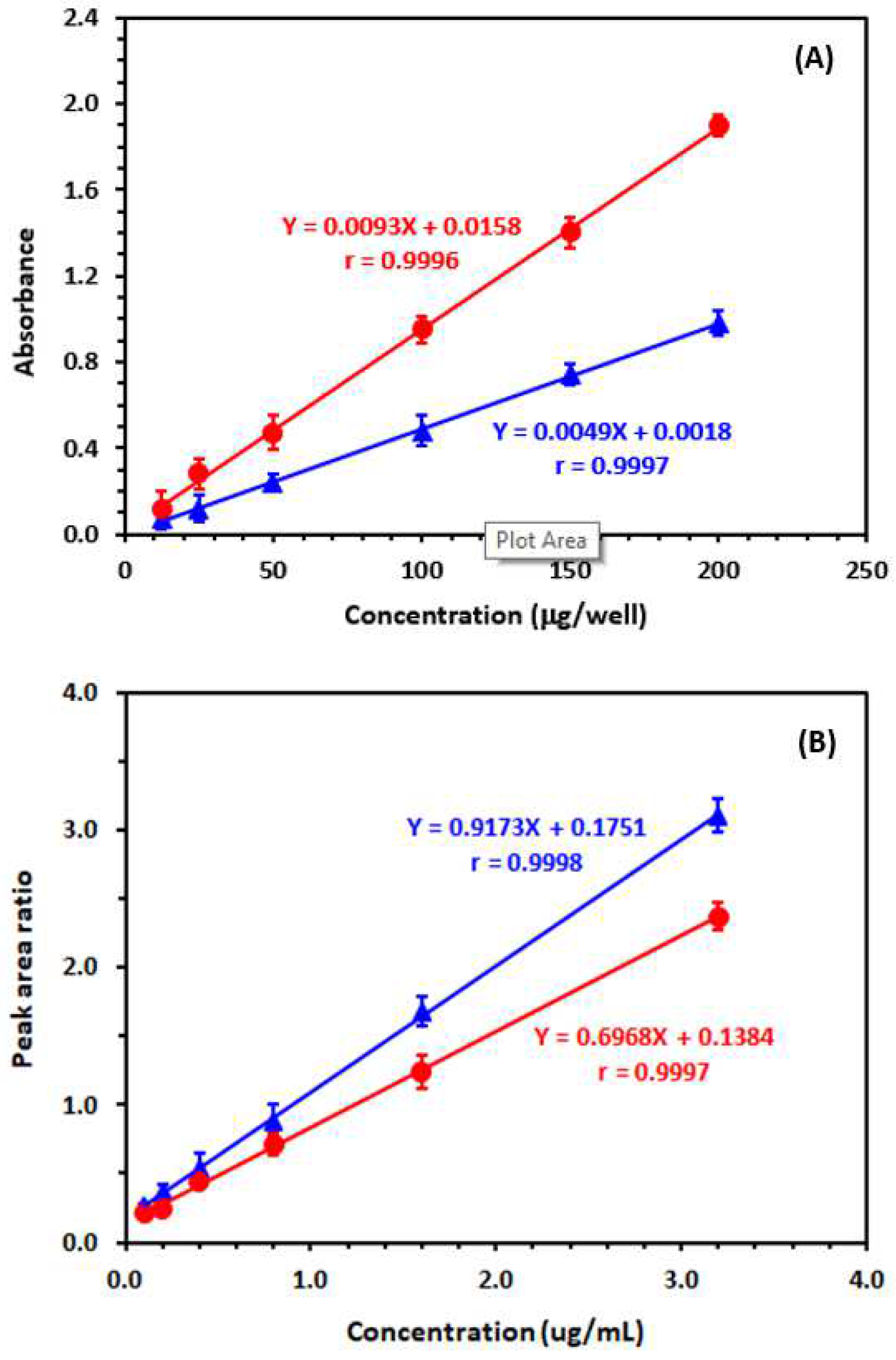
| Condition | Studied Range | Optimum Value a |
|---|---|---|
| DDQ conc. (%, w/v) | 0.125–0.8 | 0.5 |
| Solvent | Different b | Methanol |
| Reaction time (min) | 0–30 | 5 |
| Temperature (°C) | 25–50 | 25 |
| λmax (nm) | 400–800 | 460 c |
| Parameter | Value | |
|---|---|---|
| DUV | SEL | |
| Retention time (min) | 3.25 | 4.20 |
| Retention factor (k′) | 1.196 | 1.857 |
| Separation factor (α) | 1.55 | 1.55 |
| Resolution factor (Rs) | 2.64 | 2.64 |
| Peak asymmetry factor | 1 | 1 |
| Number of theoretical plates (N) per meter | 8002 | 8939 |
| Parameter | Value for MW-SPM | Value for HPLC-FD | ||
|---|---|---|---|---|
| DUV | SEL | DUV | SEL | |
| Linear range a | 14.52–200 | 10.46–200 | 0.12–3.2 | 0.15–3.2 |
| Intercept | 0.0018 | 0.0158 | 0.1751 | 0.1384 |
| Standard deviation of intercept | 7.11 × 10−3 | 9.73 × 10−3 | 0.0834 | 0.1056 |
| Slope | 0.0049 | 0.0093 | 0.9173 | 0.6968 |
| Standard deviation of slope | 5.466 × 10−6 | 4.389 × 10−5 | 0.0075 | 0.0094 |
| Correlation coefficient | 0.9997 | 0.9996 | 0.9998 | 0.9997 |
| LOD a | 4.4 | 3.17 | 0.03 | 0.05 |
| LOQ a | 14.52 | 10.46 | 0.12 | 0.15 |
| Taken Conc. a | Relative Standard Deviation (%) b | Recovery (% ± SD) a | |
|---|---|---|---|
| Intra-Assay, n = 3 | Inter-Assay, n = 3 | ||
| MW-SPM | |||
| DUV | |||
| 20 | 1.29 | 2.23 | 100.2 ± 1.8 |
| 100 | 1.02 | 1.82 | 101.4 ± 2.1 |
| 160 | 1.62 | 2.41 | 98.5 ± 1.8 |
| SEL | |||
| 20 | 1.82 | 2.14 | 100.2 ± 2.2 |
| 100 | 1.46 | 2.05 | 99.4 ± 1.9 |
| 160 | 2.01 | 2.27 | 102.5 ± 2.4 |
| HPLC-FD | |||
| DUV | |||
| 0.5 | 1.24 | 1.41 | 101.4 ± 1.2 |
| 1.5 | 0.89 | 1.22 | 100.2 ± 1.5 |
| 3.0 | 0.98 | 1.54 | 99.8 ± 1.2 |
| SEL | |||
| 0.5 | 1.32 | 1.58 | 101.4 ± 1.4 |
| 1.5 | 1.04 | 1.04 | 98.8 ± 1.5 |
| 3.0 | 1.52 | 1.72 | 100.2 ± 1.8 |
| Nominated Conc. a | Recovery (% ± SD) b | |
|---|---|---|
| Copiktra Capsules (25 mg DUV) | SEL Capsules (LM) c (100 mg SEL) | |
| MW-SPM | ||
| 25 | 101.2 ± 1.2 | 102.2 ± 1.3 |
| 50 | 100.4 ± 1.4 | 100.1 ± 1.6 |
| 100 | 99.5 ± 1.8 | 99.8 ± 1.2 |
| 150 | 97.9 ± 1.2 | 101.4 ± 1.1 |
| Mean | 99.8 ± 1.4 | 100.9 ± 1.1 |
| HPLC-FD | ||
| 0.2 | 98.5 ± 1.1 | 100.1 ± 1.5 |
| 0.5 | 100.2 ± 1.2 | 98.5 ± 1.2 |
| 1.5 | 99.4 ± 1.5 | 98.8 ± 0.9 |
| 3.0 | 99.6 ± 0.8 | 99.7 ± 1.4 |
| Mean | 99.4 ± 0.7 | 99.2 ± 0.8 |
Publisher’s Note: MDPI stays neutral with regard to jurisdictional claims in published maps and institutional affiliations. |
© 2022 by the authors. Licensee MDPI, Basel, Switzerland. This article is an open access article distributed under the terms and conditions of the Creative Commons Attribution (CC BY) license (https://creativecommons.org/licenses/by/4.0/).
Share and Cite
Aljohar, H.I.; Alghamdi, A.A.; Khalil, N.Y.; Darwish, H.W.; Al-Salahi, R.; Darwish, I.A. Development and Validation of 96-Microwell-Based Spectrophotometric and High-Performance Liquid Chromatography with Fluorescence Detection Methods with High Throughput for Quantitation of Duvelisib and Seliciclib in Their Bulk Forms and Capsules. Appl. Sci. 2022, 12, 10624. https://doi.org/10.3390/app122010624
Aljohar HI, Alghamdi AA, Khalil NY, Darwish HW, Al-Salahi R, Darwish IA. Development and Validation of 96-Microwell-Based Spectrophotometric and High-Performance Liquid Chromatography with Fluorescence Detection Methods with High Throughput for Quantitation of Duvelisib and Seliciclib in Their Bulk Forms and Capsules. Applied Sciences. 2022; 12(20):10624. https://doi.org/10.3390/app122010624
Chicago/Turabian StyleAljohar, Haya I., Abdulmajeed A. Alghamdi, Nasr Y. Khalil, Hany W. Darwish, Rashad Al-Salahi, and Ibrahim A. Darwish. 2022. "Development and Validation of 96-Microwell-Based Spectrophotometric and High-Performance Liquid Chromatography with Fluorescence Detection Methods with High Throughput for Quantitation of Duvelisib and Seliciclib in Their Bulk Forms and Capsules" Applied Sciences 12, no. 20: 10624. https://doi.org/10.3390/app122010624








